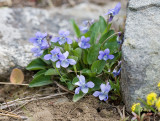By Graduate Research Associate Evan Hayduk
Basic information:
Viola adunca, or early-blue violet, is a short perennial with short slender rhizomes. Leaves are alternate, heart shaped to ovate. The flowers of this viola are blue to deep violet, but can often be whitish at the base. Flowers have 5 petals, and bloom from April to August. Fruit are born in capsules with three valves, and the explosiveness of the splitting of the capsules often makes seed collection tricky.
Ecological Importance:
The Mardon skipper (Polites mardon) butterfly depends on Viola adunca as a spring-flowering nectar source. The small orange butterfly is found on two South Sound prairies, and is listed as a State Endangered Species and is a Federal Candidate Species. Zerene fritillaries (Speyeria zerene) also use Viola adunca, but as a larval host. Three subspecies of the Zerene Fritillary are listed on the U.S. Endangered Species List, including the Oregon Silverspot which is classified as threatened in California, Oregon and Washington.
Studies have found that Viola adunca are poor competitors, and are easily displaced by invasive species. Non-native grasses increase thatch density and vegetation height, compete for resources and reduce open space for germination and thus reduce Viola adunca populations. Experiments also show that fire stimulates germination in Viola adunca, and fire could be used to increase Viola adunca populations and provide more area for nectar and larval hosting for butterflies.
Fun facts:
Violet leaves contain more vitamin A than spinach, and a half-cup of leaves has more vitamin C than four oranges! Now, don’t go out and start eating, Viola adunca is a very important larval host and nectar source for threatened butterflies. Another reason to limit consumption: its rhizomes, fruits and seeds are poisonous. Adunca means hooked, and other common names include the hooked-spur violet and the western dog violet.


12 Comments:
James
Nice article. Acerola is also one of super fruits when it comes to vitamin c content, I think its 20x the amount an orange has. http://www.canyouoverdoseonvitaminc.com
my site
Howdy! I simply wish to give an enormous thumbs up for the great info you will have here on this post. I will likely be coming back to your blog for more soon.
Wencke
Violet leaves taste great! Just satrted using them as a base for chili and veggie soups. I fill the blender with tomatoes fresh from the garden, add approx. 2 cups violet leaves, puree, then proceed with the recipe as usual. YUMMY!!
Annie Hayes
Another thumbs up ! Best info on this violet anywhere on the web ! Thank you !
Annie
SpinachChris
Evan, who knew that Early Blue Violets have more vitamin A than spinach. Nature always seems to surprise.
spinach
Cinda
I am regular visitor, how are you everybody? This paragraph posted
at this weeb page is actually pleasant.
Jaimie
A motivating discussion is definitely worth
comment. I do think that you should publish more about this subject matter, it might not be a
taboo subject but typically people don’t
speak about these topics. To the next! Kind regards!!
Chez Laurine
Hi tto every , because I am really keen off reading this weblog’s post to be updated regularly.
It consists of pleasant material.
bloompedia
woooww i like it.. tahnk you for informatyion… nice post…!
joker81
Great article! The analysis of how emerging technologies are impacting the workforce is both insightful and balanced. I’d love to see more on Joker81 how educational institutions can adapt to these changes. Overall, a well-researched and engaging read. Looking forward to more of your work
julia cruise
Your article gave me a lot of inspiration. If you’re interested in more content like this, check out this website: バーキン コピー.
repagay123
The challenges it faces from invasive species and the potential benefits of fire to stimulate its germination are also very interesting gbi iq test